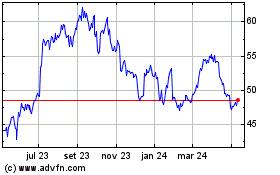Stock Market News for January 9, 2012 - Market News
09 Janeiro 2012 - 7:06AM
Zacks
The fact that the US unemployment
rate has dropped to its lowest level since February 2009 failed to
spark a rally on Friday. European concerns weighed on sentiment to
drag the benchmarks marginally lower. However, the first week of
2012 ended on a positive note amidst a slew of encouraging economic
reports,
On Friday, the Dow Jones Industrial
Average (DJIA) dropped 0.5% to close the day at 12,359.92. The
Standard & Poor 500 (S&P 500) was down 0.3% and closed
Friday’s trading session at 1,277.81. However, the tech-laden
Nasdaq Composite Index registered gains of 0.2% and finished at
2,674.22. The fear-gauge CBOE Volatility Index (VIX) reflected
subdued fears, dropping almost 4% to close at 20.63. Consolidated
volumes on the New York Stock Exchange, the Nasdaq and Amex were
roughly 6.3 billion shares, substantially lower than last year's
daily average of 7.84 billion shares. On the NYSE, for every seven
stocks that gained, eight stocks were on the declining side.
Late-December’s slew of economic
reports had sparked a ‘Santa’ rally that ultimately led to the
S&P 500 ending the year on a positive note and Dow extended its
yearly gains. The first week of 2012 was also witness to strong US
economic data, lifting the benchmarks to a green finish in the
first week of the year. Labor, housing and ISM data were all
positive through the week and the Dow, S&P 500 and Nasdaq ended
the week after gaining 1.2%, 1.6% and 2.7%, respectively. Through
the week, investor mood displayed declining anxiety as the
fear-gauge index, or, VIX, dropped 12% for the week.
On Friday as well, the economy had
good news to share with the investors, with the unemployment rate
declining to its lowest level since February 2009. The U.S. Bureau
of Labor Statistics reported that nonfarm payroll employment
increased 200,000 in December 2011, and the unemployment rate
declined to 8.5% from the revised figure of 8.7% posted in November
2011.
However, this report failed to
overshadow lingering European concerns. The euro continued its
slide with sovereign funding remaining a major concern, falling
below $1.27. It was for the first time since September 2010 that
the euro slid below that level. Meanwhile, borrowing costs of Italy
continued to tread around levels considered ‘unsustainable’.
Italy’s 10-year yield hovered around 7.1%. A figure of 7% or higher
is considered a very risky affair for any of these nations and
Ireland and Portugal both had to seek rescue funds when their
borrowing costs crossed the 7% mark.
For the week, the KBW Bank Index
(BKX) had gained 5.7%, but on Friday it declined by 0.3%. Among the
financial stocks, Bank of America Corporation (NYSE:BAC), The
Goldman Sachs Group, Inc. (NYSE:GS), Morgan Stanley (NYSE:MS),
American Express Company (NYSE:AXP) and U.S. Bancorp (NYSE:USB)
declined 2.1%, 1.2%, 2.3%, 1.1% and 0.8%, respectively.
The energy sector was also under
some pressure on Friday and the Energy Select Sector SPDR (XLE)
fund was down 0.6%. Energy stocks like Transocean Ltd. (NYSE:RIG),
Schlumberger Limited (NYSE:SLB), Chevron Corporation (NYSE:CVX),
ConocoPhillips (NYSE:COP) and Exxon Mobil Corporation (NYSE:XOM)
dropped 1.1%, 0.4%, 0.7%, 0.8% and 0.8%, respectively.
AMER EXPRESS CO (AXP): Free Stock Analysis Report
BANK OF AMER CP (BAC): Free Stock Analysis Report
CONOCOPHILLIPS (COP): Free Stock Analysis Report
CHEVRON CORP (CVX): Free Stock Analysis Report
GOLDMAN SACHS (GS): Free Stock Analysis Report
MORGAN STANLEY (MS): Free Stock Analysis Report
TRANSOCEAN LTD (RIG): Free Stock Analysis Report
SCHLUMBERGER LT (SLB): Free Stock Analysis Report
US BANCORP (USB): Free Stock Analysis Report
EXXON MOBIL CRP (XOM): Free Stock Analysis Report
To read this article on Zacks.com click here.
Zacks Investment Research
Schlumberger (NYSE:SLB)
Gráfico Histórico do Ativo
De Jun 2024 até Jul 2024

Schlumberger (NYSE:SLB)
Gráfico Histórico do Ativo
De Jul 2023 até Jul 2024
